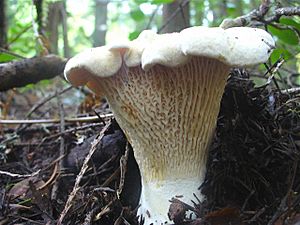White chanterelle facts for kids
Quick facts for kids White chanterelle |
|
|---|---|
 |
|
| Scientific classification | |
| Genus: |
Cantharellus
|
| Species: |
subalbidus
|
| Cantharellus subalbidus | |
|---|---|
| Mycological characteristics | |
| ridges on hymenium | |
| cap is infundibuliform | |
| hymenium is decurrent | |
| stipe is bare | |
| spore print is white | |
| ecology is mycorrhizal | |
| edibility: choice | |
The white chanterelle, known scientifically as Cantharellus subalbidus, is a special type of fungus found in North America. You can find it growing in places like California and the Pacific Northwest. This mushroom is part of the Cantharellus family, which includes many popular and tasty edible chanterelles. It looks a lot like other chanterelles, but its color is usually cream to white. If you gently bruise it, you might see an orange mark appear!
Cantharellus subalbidus often grows by forming a special partnership with certain trees. This partnership is called a mycorrhizal association. It helps both the mushroom and the tree get nutrients. These fungi often team up with pine trees, hemlock trees, Douglas-fir trees, and Pacific madrone trees. Scientists have found that white chanterelles are more common in older forests than in younger ones.
Spotting Similar Mushrooms
When you are looking for mushrooms, it is important to know which ones are safe to eat. Several other types of chanterelles grow in western North America. They might look a bit like the white chanterelle. Some of these include:
- C. californicus
- C. cascadensis
- C. cibarius var. roseocanus
- C. formosus
There are also other fungi that might look a little like C. subalbidus. These include Hygrophoropsis aurantiaca, Chroogomphus tomentosus, and mushrooms from the groups Craterellus, Gomphus, Omphalotus, and Polyozellus. Always be sure you know what you are picking before eating any wild mushroom!
Cooking with White Chanterelles
The white chanterelle is considered a "choice edible" mushroom. This means it is very tasty and safe to eat! You can prepare these mushrooms in different ways. One popular method is to sauté them in a pan. You can also cut them into pieces and bake them. Try baking them at 350° Fahrenheit (about 175° Celsius) for about 10 minutes. They make a delicious addition to many meals!

